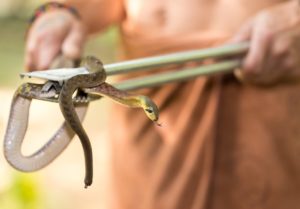
Here, you also need to consider the type and physique of the snake and its diet before picking the trapping device. Since little knowledge is a dangerous thing and fails to bear fruitful results, we have given elaborate answers to the questions: how does a snake trap work and what factors play a vital role in its effective performance?
Give this article a careful read and you will not have any trouble when setting your next trap.
Table of Contents
How Does a Snake Trap Work
Snake traps come in various types, but the basic principle of each is the same: to catch snakes for you. Another thing common in all traps is the requirement of some sort of snake attractant substance. Some already have a scent lure or inanimate bait, while you have to put bait in others to draw the snake.
You set the trap in that spot in your house that the snake frequently visits. Snakes are very picky about locations. They don’t lounge just about anywhere in the house. They prefer cool, shady and secluded areas. That’s why the most common snake-invasion places are your yard, garden, basement, attic, storage, under the porch or shed.
When you place the trap in the designated spot, the attractive substance/bait pulls the snake towards itself. The slithering creature gets into the trap to snack on the bait and bullseye! It’s stuck!
Crucial Factors to Consider
A snake trap will work and deliver the desired result only if you consider the following crucial factors.
-
Identification of the Culprit Snake
First comes the identification of the snake. You need to identify the type and family lineage of the snake, its size, nature and food preference. These clues will help you decide which trap you should choose.
For instance, I have got a baby garter snake or an adult pit viper hanging around my house. I can’t pick a small glue box trap and expect it to work on both. I will need a large wooden box trap for the venomous viper and a small glue trap for the little garter.
-
Trap’s Location
Next comes the strategic location of the trap. You need to monitor your land to see where you often get a glimpse of that problematic snake. If you see it coming and going out of your yard or basement, then that’s where you should set the trap.
A Trick: The arrangement of the trap should be as such that it blends in with the surroundings to trick the snake.
-
Bait or Attractant
The bait is that magic spell that draws the snake to the trap. Many traps available in the market use scent lures or some inanimate attractant substance to entice the serpent. I prefer to bait the traps myself with live objects, such as rats, slugs or fresh eggs of birds or hens. These are the top favourite dishes of the majority of snakes. That’s why traps with one of these baits will definitely catch the critter for you.
-
The Waiting Part
The trap is chosen; the location is picked; the bait is added. Now, it’s all the wait-and-watch game. You need to regularly check the trap to see whether the culprit is confined or still hanging around freely.
Once confirmed that the creature is captured, you should take the apparatus to a place where you can set the prisoner at large.
Precautions While Catching Snakes in Traps
Venomous or non-venomous, one thing is common in all snakes: each can inflict a mean bite and make you cry like a baby because of pain. You will need immediate medical attention in case of a snakebite.
Professional snake exterminators put a lot of emphasis on the use of snakeproof clothing on your hands, arms and feet to avoid painful bites.
They also advise you to not get too close to a trapped snake. Instead, you should use tools, such as snake hooks or tongs, to tackle a snake.
Furthermore, when you are relocating the snake, ensure the release location is a couple of miles away from your residence.
Also, unlatch the trap in the direction that allows the snake to slither in your opposite direction and not towards you.
Once done, you can get behind the wheel and drive back home.
Conclusion
People with serious snake problems have an effective solution for that in the form of snake traps. Their types may vary but they all work to catch the serpent you want to confine. All traps require some type of bait to lure the culprit snake. You will have to place the apparatus in a spot where the slithering creature is sighted more than once. Daily check the trap to relocate the prisoner snake on time to prevent it from rotting. Afterwards, you can set the trap for the next catch.
